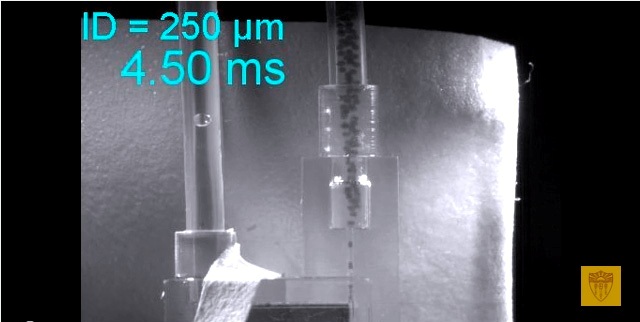Feb 25 2016
Nanoparticles are very small particles, found in many products, ranging from high-definition television sets and drug delivery formulations, to pollution control on cars.
 Nanoparticles form in a 3D-printed microfluidic channel. Each droplet shown here is about 250 micrometers in diameter, and contains billions of platinum nanoparticles. (Courtesy of Richard Brutchey and Noah Malmstadt)
Nanoparticles form in a 3D-printed microfluidic channel. Each droplet shown here is about 250 micrometers in diameter, and contains billions of platinum nanoparticles. (Courtesy of Richard Brutchey and Noah Malmstadt)
These particles are much smaller than the width of a human hair, and possess unique properties. They have an increased surface area, and play an important role in both industrial and scientific research. However, fabrication of these tiny particles is a costly and complicated process.
Researchers from the University of Southern California (USC) have developed a new method to produce nanoparticles. This method is expected to transform the large-scale, automated assembly line process by replacing the existing batch-by-batch production operation, which is tedious and takes a considerable amount of time.
Noah Malmstadt of the USC Viterbi School of Engineering and Richard Brutchey of the USC Dornsife College of Letters, Arts and Sciences, headed the research team that successfully developed the method. The results of the study have been reported in Nature Communications.
Usually, when foreign objects penetrate cell membranes, they tend to kill or damage the cells. Gold nanoparticles are capable of penetrating the cell membranes without damaging them. This unusual ability of gold nanoparticles makes them suitable to deliver drugs to healthy cells, as well as to deliver fatal radiation doses to tumor cells.
However the cost of a single milligram of gold nanoparticle is about $80, which means 1g of gold nanoparticle costs $80,000, whereas 1g of pure, raw gold is about $50.
It’s not the gold that’s making it expensive. We can make them, but it’s not like we can cheaply make a 50 gallon drum full of them.
Noah Malmstadt, USC Viterbi School of Engineering
The current method of nanoparticle production is performed in a chemistry laboratory, where lab technicians use standard lab flasks and beakers to manually mix the chemicals. The new method devised by Brutchey and Malmstadt is based on microfluidics technology, capable of manipulating small fluid droplets in narrow channels.
In order to go large scale, we have to go small.
Richard Brutchey, USC Donsife College of Letters
3D printed tubes, measuring 250 µm, in diameter were used by the team. These tubes are considered to be the smallest fully enclosed tubes ever developed. For comparison, the average-sized speck of dust measures 50 micrometers wide.
A parallel network of four 3D printed tubes was built, and a combination of two non-mixing fluids (such as oil and water) was allowed to run through them. While the two fluids tried to exit via the openings, they squeezed off small droplets of fluid. Each of the droplets behaved like a micro-scale chemical reactor, where materials are combined generating nanomaterials. Each of these microfluidic tubes produces countless number of similar droplets, which execute the same reaction.
A similar system was envisioned by researchers prior to this, but it could not be scaled up successfully because of the limitations in the parallel structure. In such structures, if one tube gets jammed a ripple effect of changing pressures is created along its neighbors, collapsing the entire system. It is similar to losing a Christmas light in one of the old-style strands, where if you lose one, you lose all of them.
Nanoparticle Production
(Courtesy of Richard Brutchey and Noah Malmstadt)
Brutchey and Malmstadt overcame this issue by changing the tubes geometry, and shaping the junction between them so that the particles that come out have a uniform size, while the system is protected against pressure changes.
Brutchy and Malmstadt teamed up with USC graduate students Emily Roberts and Carson Riche; and Malancha Gupta of USC Viterbi.
The National Science Foundation, grant CMMI-1436872 supported the study.